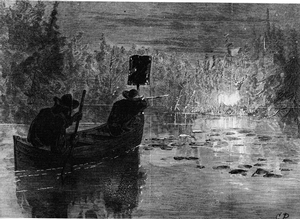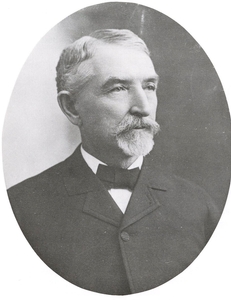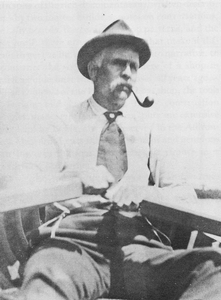Guideboats in the 19th Century
Guideboats were created to be fast, lightweight, portable, and spacious enough for gear and passengers. By the end of the 19th Century, they were the predominant boat on Adirondack waterways. Exclusive to the Adirondacks, the guideboat was a symbol of the uniqueness of the region. The term “guideboat” refers to the Adirondack guides who commonly used them.
The early settlers in the Adirondacks would offer hospitality and knowledge of the region to travelers. Eventually they started to make a profit from those travelers by opening inns, which grew into a guiding industry in the Adirondacks. Tourists would go to the Adirondacks to hunt, fish, and explore the interior of the region. Guides were responsible for shelter, transportation, food, hunting and fishing expertise, and anything else the client needed. Guides were incredibly well respected in the park and became a symbol of Adirondack recreation (Bond, 1995). The guideboat was an essential tool of the Adirondack guide, allowing him to efficiently transport clients and gear while still being able to carry the boat on his own.

Both guides and traders would use guideboats as hunting vessels in the interior of the Adirondacks. The oars could be dropped for short periods of time while the hunter shot at the game and the boat could be used to carry heavy loads, making it the perfect hunting vessel. The boats were quick and silent in pursuit of deer, and were often used for hunting practices that are now illegal. Some hunters used a technique called “hounding”, involving chasing the deer into the water with dogs and catching the deer in the boat while it was slowly swimming. Others hunted by “jacking”, which involved attaching bright lights to the front of a guideboat and shining a light at deer on the shore to stun and shoot them. In both of these cases, guideboats were extremely helpful in quickly and easily hunting a huge amount of deer.
By 1880 to 1890, the guideboats reached their peak in the Adirondacks. Local hunters and trappers used almost exclusively guideboats to navigate the tricky waterways to the interior of the North Woods, and a rise in tourism in the park created a need for the Adirondack guide with their own guideboat. Hundreds of guideboats were built each year, but only a select few builders had the skill and experience to create what Durant calls an “authentic” Adirondack guideboat.
 Two of the most famous builders of guideboats in the park were Dwight Grant along with his son, Lewis Grant. In 1881, Dwight Grant started building boats out of a small woodshop behind his house in Boonville, near the current park boundary (Durant, 1980). Dwight Grant produced about 10 to 25 guideboats each year with the help of a few assistants in his shop. Each boat sold for between $53 and $70 depending on size, usually to guides and camp owners that often bought more than one guide boat at one time. Dwight Grant continued to run the shop until 1900 when he left to become the manager of the Adirondack League Club, leaving management to his son Lewis Grant (Durant, 1980). Over Dwight Grant’s 20 years building guideboats, he made improvements to the boat to make it 20 to 30 pounds lighter. His boats, like the Ghost pictured here, are still known as some of the finest Adirondack guideboats ever created.
Two of the most famous builders of guideboats in the park were Dwight Grant along with his son, Lewis Grant. In 1881, Dwight Grant started building boats out of a small woodshop behind his house in Boonville, near the current park boundary (Durant, 1980). Dwight Grant produced about 10 to 25 guideboats each year with the help of a few assistants in his shop. Each boat sold for between $53 and $70 depending on size, usually to guides and camp owners that often bought more than one guide boat at one time. Dwight Grant continued to run the shop until 1900 when he left to become the manager of the Adirondack League Club, leaving management to his son Lewis Grant (Durant, 1980). Over Dwight Grant’s 20 years building guideboats, he made improvements to the boat to make it 20 to 30 pounds lighter. His boats, like the Ghost pictured here, are still known as some of the finest Adirondack guideboats ever created.
Long Lake was an important place in the development of the guideboat, and the peak of guideboats in Long Lake came with the arrival of boat builder Warren Cole. Cole’s boatshop was built on the shores of Long Lake in 1892, where he built boats for 16 years (Durant, 1980). His boats were known as some of the finest in the Adirondacks and were known for being exceptionally steady. They were popular in hotels and camps with children learning to row. Cole’s boats continued to be popular until his shop closed in 1909.
Image References:
Top Right: Floating for deer in the Adirondacks, Harper's Weekly, 1868. Printed in Durant, 1980: "The Adirondack Guide-boat", p. 31.
Left: Dwight Grant, guide, boatbuilder, legislator. Durant, 1980: "The Adirondack Guide-boat", p. 44.
Bottom Right: Warren Cole. Durant, 1980: "The Adirondack Guide-boat", p. 58.
